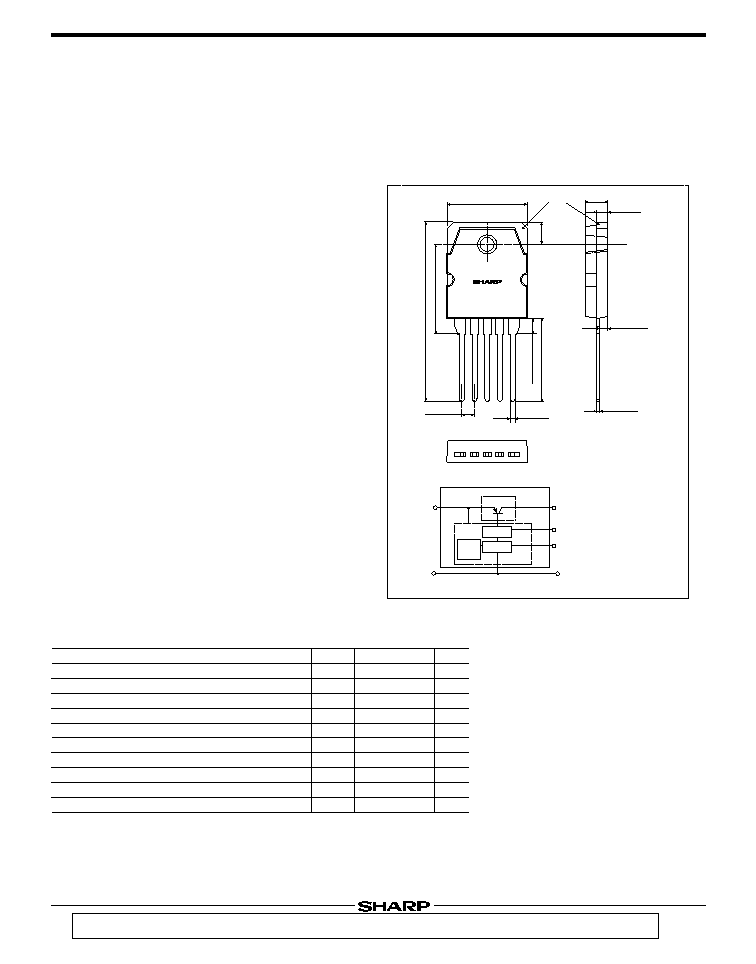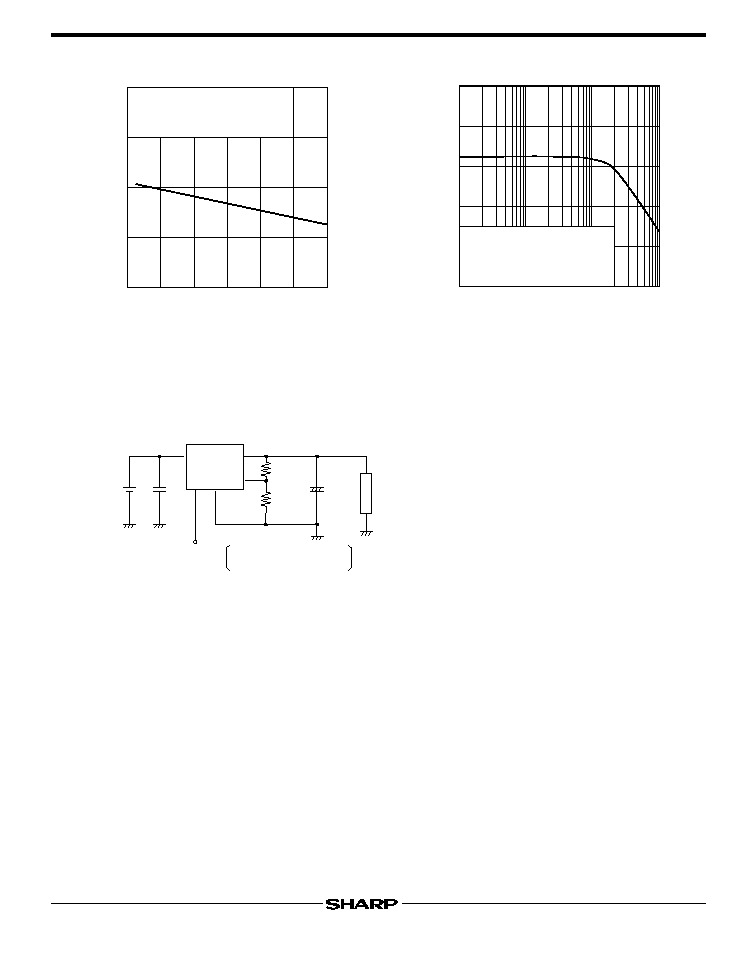 | –≠–ª–µ–∫—Ç—Ä–æ–Ω–Ω—ã–π –∫–æ–º–ø–æ–Ω–µ–Ω—Ç: PQ7DV10 | –°–∫–∞—á–∞—Ç—å:  PDF PDF  ZIP ZIP |

" In the absence of confirmation by device specification sheets,SHARP takes no responsibility for any defects that may occur in equipment using any SHARP devices
shown in catalogs,data books,etc.Contact SHARP in order to obtain the latest version of the device specification sheets before using any SHARP's device. "
Low Power-Loss Voltage Regulators
PQ7DV10
s
Outline Dimensions
PQ7DV10
(Unit : mm)
Parameter
Symbol
Rating
Unit
V
IN
V
C
V
ADJ
I
O
P
D1
P
D2
T
j
T
opr
T
stg
T
sol
10
10
5
10
2.2
60
150
-20 to +80
-40 to +150
260 (For 10s)
V
V
V
A
W
W
∞C
∞C
∞C
∞C
Input voltage
ON/OFF control terminal voltage
Output adjustment terminal voltage
Output current
Power dissipation (No heat sink)
Power dissipation (With infinite heat sink)
Junction temperature
Operating temperature
Storage temperature
Soldering temperature
*1
*1
*1
*2
*1
All are open except GND and applicable terminals.
*2
Overheat protection may operate at 125=<T
j
=<150∞C.
s
Absolute Maximum Ratings
(T
a
=25∞C)
Variable Output, (1.5 to 7V) 10A Output Low Power-loss Voltage Regulator
s
Feature
°10A output type
°Low power-loss (Dropout voltage : MAX.0.5V at Io=
10A)
°Variable output type (1.5 to 7V)
°Low operating voltage (Minimum input voltage : 3.0V)
°High-precision reference voltage type
(Reference voltage precision :
±
2.0%)
°TO-3P package
°Built-in ON/OFF control function
°Built-in overcurrent protection, overheat protection
function
s
Applications
°Power supplies for various electronic equipment such as
personal computers
PQ7DV10
1
2
4
5
3
6
IC
chip
PNP T
r
chip
Reference
voltage
Comparator
Controller
1 DC input (V
IN
)
2,6 DC output (V
O
)
3 GND
4 ON/OFF control
terminal (V
C
)
5 Output voltage minute
adjustment terminal (V
ADJ
)
4.5±0.2
17.0MAX
2.0±0.2
1
2
3
4
5
6
39.0MAX
19±0.5
5±0.2
3.7MAX
17.0MIN
4-(2.54)
5-0.8±0.2
(0.6)
(1.4)
∑ Please refer to the chapter" Handling Precautions ".

Low Power-Loss Voltage Regulators
Fig.3
Power Dissipation vs. Ambient
Temperature
Fig.4
Overcurrent Protection
Characteristics(Typical Value)
Fig.1
Test Circuit
Fig.2
Test Circuit for Ripple Rejection
Parameter
Symbol
Conditions
Input voltage
Reference voltage
Reference voltage
Load regulation
Line regulation
Temperature coefficient of output voltage
Ripple rejection
Dropout voltage
ON-state voltage for control
ON-state current for control
OFF-state voltage for control
OFF-state current for control
Quiescent current
Unit
MAX.
TYP.
NIN.
3
1.5
1.225
-
-
-
45
-
2
-
-
-
-
-
-
1.25
0.5
0.5
±0.01
55
-
-
-
-
-
-
10
7
1.275
2
2.5
-
-
0.5
-
20
0.8
- 40
17
s
Electrical Characteristics
*3
In case of opening control terminal 4,output voltage turns on.
(Unless otherwise specified, conditions shall be V
IN
=5V, Io=5A, Vo=3V(R
1
=2k
) T
a
=25∞C)
V
IN
V
O
V
ref
R
eg
L
R
eg
I
T
C
V
O
RR
V
i
-o
V
C (ON)
I
C (ON)
V
C (OFF)
I
C (OFF)
I
q
-
-
-
I
O
=5mA to 10A
V
IN
=4 to 10V
T
j
=0 to 125∞C
-
V
IN
=3V, Io=10A
-
V
C
=2.7V
-
V
C
=0.4V
I
O
=0A
V
V
V
%
%
%/∞C
dB
V
V
µ
A
V
mA
mA
*3
~
V
~
q
3
q
2
q
1
q
4
q
5
A
A
V
V
A
V
IN
V
C
I
q
2k
I
O
V
O
V
C
2.7V
R
L
47
µ
F
0.33
µ
F
+
R
2
R
1
q
3
q
2
q
1
q
4
q
5
V
IN
e
i
e
o
2k
I
O
R
L
0.33
µ
F
47
µ
F
+
R
2
R
1
+
V
ref
V
ref
f=120Hz (sine wave)
e
i
=0.5V
rms
V
IN
=5V
V
O
=3V (R
1
=2k
)
I
O
=0.5A
RR=20 log (e
i
/e
o
)
V
o
=V
ref
X
(1+R
2
/R
1
)
=1.25
X
(1+R
2
/R
1
)
[R
1
=2k
,V
ref
=1.25V]
0
-20
0
P
D1
P
D2
P
D1
:No heat sink
P
D2
:With infinite heat sink
40
20
60
80
20
10
30
40
50
60
Power dissipation P
D
(W)
Ambient temperature T
a
(∞C)
0
5
10
15
20
100
80
40
60
20
0
Relative output voltage (%)
Output current I
O
(A)
Note) Oblique line portion:Overheat protection may operate
in this area.
PQ7DV10

Low Power-Loss Voltage Regulators
PQ7DV10
Fig.5
Output Voltage Adjustment
Characteristics
Fig.6
Output Voltage Deviation vs.
Junction Temperature
Fig.7
Output Voltage vs. Input Voltage
Fig.9
Dropout Voltage vs. Junction
Temperature
Fig.8
Circuit Operating Current vs. Input
Voltage
Fig.10 Ripple Rejection vs. Junction
Temperature
2
4
1
0
3
6
5
8
7
Output voltage V
O
(V)
10
2
10
3
10
4
2
4
1
0
3
6
5
8
7
R
1
=2k
R
2
(
)
-10
-25
0
25
50
75
100
125
-6
-2
2
6
-8
-4
0
4
8
V
IN
=5V
V
O
=3V(R
1
=2k
,R
2
=2.8k
)
I
O
=2.5A
10
Output voltage deviation
V
O
(mV)
Junction temperature T
j
(∞C)
0
0
1
2
3
4
5
1
2
3
4
R
L
=
R
L
=0.6
R
L
=0.3
Output voltage V
O
(V)
Input voltage V
IN
(V)
T
a
=25∞C
V
O
=3V(R
1
=2k
,R
2
=2.8k
)
0
0
5
2
4
1
3
40
80
160
120
R
L
=
R
L
=0.3
R
L
=0.6
Circuit operating current I
BIAS
(mA)
Input voltage V
IN
(V)
T
a
=25∞C
V
O
=3V(R
1
=2k
,R
2
=2.8k
)
-25
0
50
25
100
75
125
0.5
0.4
0.2
0.3
0.1
0
Dropout voltage V
i
-O
(V)
Junction temperature T
j
(∞C)
V
O
=3V(R
1
=2k
,R
2
=2.8k
)
V
IN
:Input voltage when output voltage
is 95% in comparison with the initial value
-25
0
50
25
100
75
125
100
80
40
60
20
0
Ripple rejection RR (dB)
Junction temperature T
j
(∞C)
V
IN
=7V
V
O
=3V(R
1
=2k
,R
2
=2.8k
)
I
O
=0.5A,e
i
=0.5V
rms
f=120Hz

Low Power-Loss Voltage Regulators
Fig.12 Ripple Rejection vs. Input Ripple
Frequency
s
Typical Application
PQ7DV10
Fig.11 Quiescent Current vs. Junction
Temperature
0
-25
0
25
50
75
100
125
5
10
15
V
IN
=5V
V
O
=3V(R
1
=2k
,R
2
=2.8k
)
I
O
=0A
20
Quiescent current I
q
(mA)
Junction temperature T
j
(∞C)
0
0.1
10
1
100
20
40
60
100
80
Input ripple frequency f
(kHz)
Ripple rejection RR (dB)
V
IN
=5V
V
O
=3V(R
1
=2k
,R
2
=2.8k
)
Io=0.5A,e
i
=0.5V
rms
,
T
a
=25∞C
q
2
q
3
q
4
q
1
q
5
Load
2k
R
1
R
2
C
O
+
V
O
C
IN
V
IN
High or Open :Output ON
Low :Output OFF
ON/OFF
Signal



